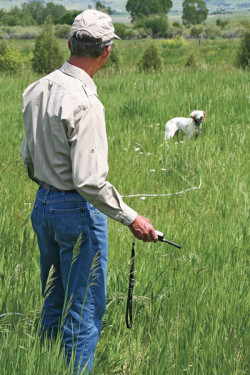 Over the course of the last several years, I've been mobbed in airports, restaurants and malls by fans of this column. And both of them wanted to know the same thing: "Dude! Just how is it you can produce a completely trained bird dog in only five months?"
Over the course of the last several years, I've been mobbed in airports, restaurants and malls by fans of this column. And both of them wanted to know the same thing: "Dude! Just how is it you can produce a completely trained bird dog in only five months?"
The short answer is that I don't have much else to do. Writing isn't a bad way to make a living; you crank out a few inspired stories a month and then sit around and wait for fame to increase your bank account.
But even if I weren't penning monthly volumes of transcendent prose — even if (gasp!) I had to get a real job — I could still train a dog in five months.
Here's why: pacing. There's no need to stretch out the training of any bird dog over two or three years, although that's what almost everybody does. Certainly, that will work. But I operate on the theory that the sooner I can get the dog thinking right, the sooner I can get it into the field to hunt with a reasonable degree of control. Control in the training phase is everything because, to a large extent, you give up much of that control the minute you unleash a dog on his first real hunt.
So my entire program, from start to finish, takes roughly five months. That includes collar conditioning, acclimation to gunfire, whoa breaking, recalling to whistle and voice, heel training, steadiness training, and as often as not, force breaking, usually in that order. That seems like a lot, but if I can do it, so can you. Really.
To accomplish that much, you have to keep moving forward. Sometimes, moving forward means backtracking, or giving your dog a rest. But once the dog has grasped what it needs to grasp, you renew his forward progress.
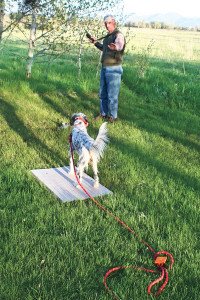 If the dog hasn't been introduced to birds, that's what I introduce first. I'll plant pigeons in the training field, then let the dog find them, point them, and chase them. What I'm trying to determine is how much prey drive the dog has so I know what I've got to work with.
If the dog hasn't been introduced to birds, that's what I introduce first. I'll plant pigeons in the training field, then let the dog find them, point them, and chase them. What I'm trying to determine is how much prey drive the dog has so I know what I've got to work with.
There's no attempt to correct or stop him from chasing at this point; the entire exercise is to get the dog excited about finding birds. When I see what I'm looking for, the dog is temporarily taken off birds and moved to the first phase of training.
My first formal training is collar conditioning. Since I will use a collar in every phase of my training for the next five months, it's absolutely critical that the dog understands how to respond to it correctly. I collar condition dogs using the "kennel" command, aka the George Hickox style. Typically, this phase will last two or three weeks, but sometimes longer. This is one area you don't want to skimp on: continue with whatever method you use until your dog absolutely understands what that stimulation around his neck is for.
The "whoa" command is next. Again, there are as many ways to train this command as there are dog trainers like me writing about it. Pick one you like and stick to it. I use a whoa board; other perfectly civilized trainers use barrels and whoa posts.
But now is where you'll begin balancing your dog's ability to learn with the time in which you have to train him. I train twice a day, six days a week, for short periods of time. And I mean short — in the first few weeks of training, an entire session may last only five or six minutes. If I can get the dog doing what I want him to do, he's finished until the next session.
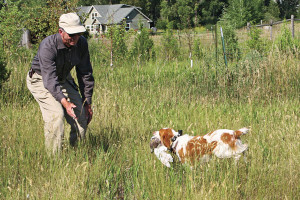 There are advantages to training frequently for short periods rather than less frequently for longer periods. First, you avoid boring your dog. And second, it allows you to structure your day so that, if needed, you can concentrate on training one command in the morning and another in the afternoon.
There are advantages to training frequently for short periods rather than less frequently for longer periods. First, you avoid boring your dog. And second, it allows you to structure your day so that, if needed, you can concentrate on training one command in the morning and another in the afternoon.
As you progress, and your dog learns how to learn, it's entirely permissible — and often a good idea — to blend the training of two commands into one session, but at first, keep them separate and distinct: one command per session.
Here's how that works. Let's say you've introduced your dog to birds and he's up to speed on his collar conditioning. Now you're running him through his whoa training on a lead, but he's not yet learned to obey you when he's off lead. You're four or five weeks into your five-month program (a fairly typical rate of progression), but you want to move ahead. Should you move on to the next phase of training, recalling to whistle and voice?
Sure. But you don't want to abandon your whoa training just yet, nor should you. Continue with whoa work during your morning session and introduce your kibble muncher to recall work during the afternoon session. Give it a few days and see how it goes. If he progresses in both areas, you're golden. If he becomes flustered and stalls out, go back to training just one command, twice a day.
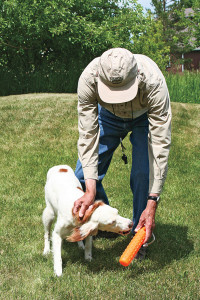 As your dog progresses and becomes a better student, you can move to teaching the next command even if the previous command is almost, but not quite, completely ingrained. If, for instance, a dog's whoa training is nearly complete but rough around the edges, I may well begin training him to recall, although I'll continue to reinforce his whoa training for the rest of the summer by throwing in a quick whoa drill at the tail end of his recall work (or whatever else he may be learning).
As your dog progresses and becomes a better student, you can move to teaching the next command even if the previous command is almost, but not quite, completely ingrained. If, for instance, a dog's whoa training is nearly complete but rough around the edges, I may well begin training him to recall, although I'll continue to reinforce his whoa training for the rest of the summer by throwing in a quick whoa drill at the tail end of his recall work (or whatever else he may be learning).
Since he's already 90 percent of the way to completely grasping "whoa," it usually won't interfere with his progress on the recall command.
Still, no matter how you structure your training sessions, you'll find that pacing almost always requires temporary backtracking. In fact, pacing is never a process of moving relentlessly forward; it is always a process of moving forward, re-evaluating your dog's progress, and then making adjustments that allow you to move forward again.
But too many people get hung up on doing the same thing over and over again, even when the dog is ready to progress. If you don't push your dog a little by giving him slightly harder tasks to accomplish when he's ready for them, he'll happily do whatever you've trained him to do but not a whit more.
To avoid that, monitor your dog's progress over several days in a row, rather than from session to session. If, for instance, your dog has been recalling to perfection for a week or so, and then, for no apparent reason, decides to disobey you, don't sweat it. All dogs do this; God only knows why. If, on the other hand, he ignores you for more than a couple sessions in a row, it's time to backtrack a few steps and reestablish a benchmark from which you can move forward once again.
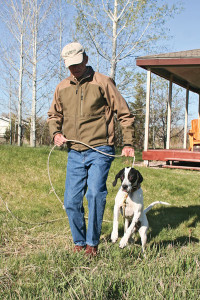 Although I usually teach commands in the order I've outlined, the only command that has to be taught first is collar conditioning. The other commands can be mixed and matched according to what works for you, and you can certainly leave out commands that you don't think you'll use. All training with almost all dogs progresses slowly during the first couple months as they learn the ropes and get used to being schooled. But the pace usually accelerates during the last two or three months, as they become better students.
Although I usually teach commands in the order I've outlined, the only command that has to be taught first is collar conditioning. The other commands can be mixed and matched according to what works for you, and you can certainly leave out commands that you don't think you'll use. All training with almost all dogs progresses slowly during the first couple months as they learn the ropes and get used to being schooled. But the pace usually accelerates during the last two or three months, as they become better students.
If I train a dog from April through August (5 months), he should be collar-conditioned, whoa-broke and trained to recall toward the end of May — not exactly rocket-like advancement. But in June, July and August, he'll learn to heel, become steady to wing, shot and (maybe) fall; learn to retrieve, become conditioned to gunfire, and have some real-time experience in the field on planted pigeons.
With a few exceptions — there are always exceptions — an intelligent, well-bred bird dog should have no trouble accomplishing that. But he won't unless you push him a little, forcing him to get just a little bit out of his comfort zone, maintaining a pace that allows for the inevitable setbacks in any training program. What's required of you is a plan, and most of all, the confidence that you'll get there.






